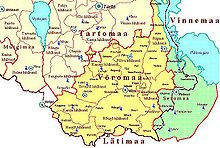Setumaa
Setumaa (in Seto and Võro Setomaa ) is a historical landscape in northeastern Europe. It includes today's southeastern Estonia and Rajon Pechory in the west of Russia .
location
Setumaa has been divided between the Estonian-Russian border since Estonian regained independence in August 1991. On the Estonian side, Setumaa includes the newly formed Setomaa municipality in Võru County . On the Russian side, this includes the area around the city of Pechory ( Estonian Petseri , German Pechur ) in the Pskow Oblast (Estonian Pihkva , German Pleskau ).
Setu people
Setumaa is named after the people of the setos (or Seto or Setu ) whose root is Setumaa home. They speak Seto , a Finno-Ugric language that is most closely related to Estonian. The Setu people have a strong tradition and identity of their own. The culture and folklore are different from the Estonian and Russian. Especially her folk poetry and her songs, which are called Leelo and stylistically belong to the Baltic-Finnish rune song, as well as the mythology (especially about the pagan god Peko ) have survived centuries. Today only about 5,000 Setu people live in Setumaa (other numbers speak of 10,000 to 13,000 Setu people in all of Estonia and 3,000 to 4,000 in Russia) and are in the minority compared to Estonians and Russians.
history
Archaeological finds date the first settlement of Setumaa to around 6400 BC. A Stone Age settlement was found near Meremäe . Since 862 AD, most of the settlement areas of the Setukese belonged to the Russian Empire, initially probably to the Principality of Pskov, then to the Novgorod Republic . Setumaa later came under the rule of the Grand Duchy of Moscow and then to the Russian Empire.
The Orthodox Christian faith took root in Setumaa between the 10th and 13th centuries. Stone crosses from this period can still be found today. From the 14th century the region was the border area between the princes of Pskow and the bishops of Tartu (German Dorpat ). Setumaa was thus at the interface between western and eastern Christianity. To defend the area, the princes of Pskov built the Isborsk castle and the bishops of Tartu built the fortress of Vastseliina .
With Estonia's independence and the Estonian War of Freedom , Setumaa came to Estonia in the Tartu Peace Treaty of February 2, 1920. As Petserimaa, it was an Estonian district. However, even then the majority of the inhabitants were ethnic Russians, so that Setumaa was perceived as a cultural foreign body in the interwar period .
With the occupation of Estonia by the Soviet Union in 1940, Setumaa was also occupied. On August 15, 1944, 75 percent of the former Petserimaa district was added to the Russian SFSR and incorporated into Leningrad Oblast .
When Estonian independence was regained in 1991, the administrative boundary drawn in 1944 remained in place. In the Russian-Estonian border treaty, this demarcation is also established under international law . The border treaty was signed by both governments on May 18, 2005, but has not yet been ratified by the Russian side . The treaty also divides Setumaa under international law into an Estonian and a Russian area, through which the external border of the European Union runs.
Organizations
The four Estonian municipalities of Setumaas have founded the "Association of the Municipalities of Setumaas" ( Setomaa Valdade Liit ), which aims to preserve the common cultural heritage of Setumaas. For the Setu people, the division of their homeland remains a bitter experience in history.
